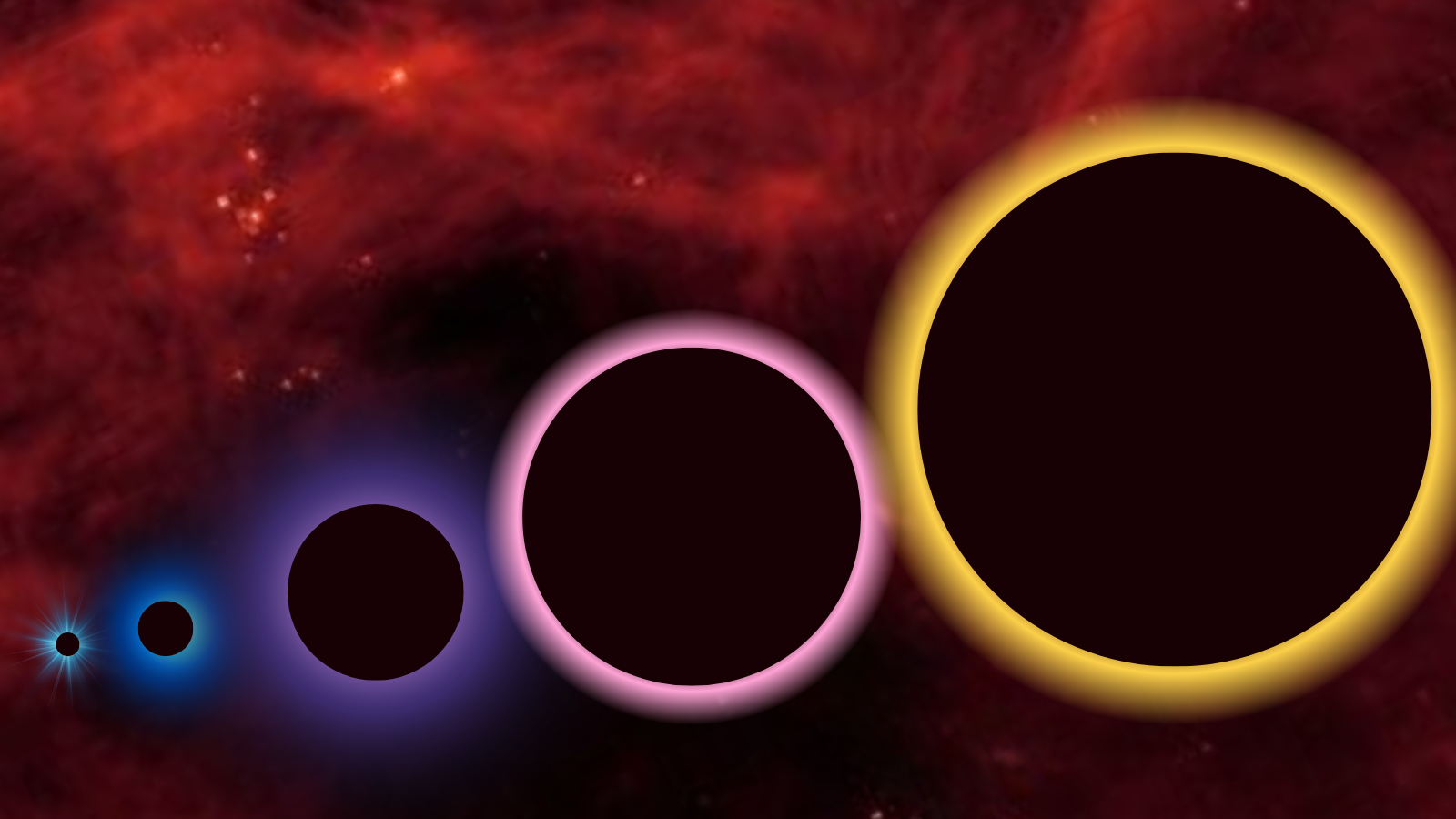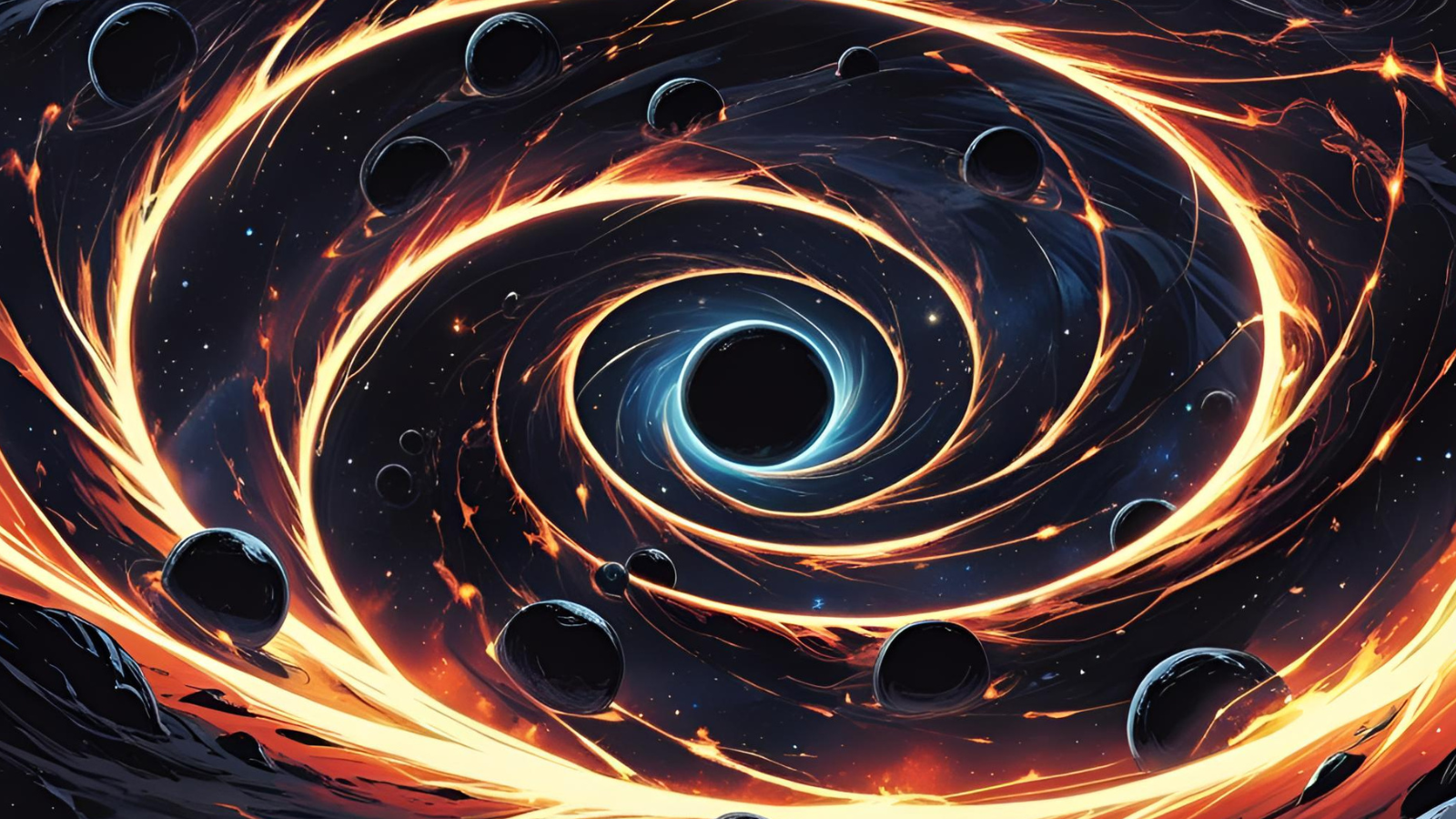Using the James Webb Space Telescope (JWST), astronomers observing a monstrous black hole in an unspoiled galaxy just 700 million years after the Big Bang have found a hint at how these celestial titans grew.
The observations could indicate that supermassive black holes in the early universe grew from so-called primordial black holes, created by density fluctuations just after the Big Bang.
This theory has an advantage over supermassive black hole formation ideas that need time for the first generation of massive stars to form and die, and then for the black holes they birth to merge and feed on copious amounts of gas and dust.
The supermassive black hole observed by JWST is A2744-QSO1 (QSO1), which has a mass of around 10 million times that of the sun, equivalent to 10% of the total mass of its host galaxy.
Supermassive black holes seen in the local universe and thus during later cosmic epochs have masses as low as 0.005% that of their galactic hosts. But the host galaxy of QSO1 isn’t just remarkably diminutive.
This galaxy, seen as it was 13 billion years ago, is also poor in metals, the name that astronomers give to elements heavier than hydrogen and helium. This indicates it has experienced very few stars exploding in supernovas and dispersing metals forged during their lifetimes.
“QSO1 is extremely poor in oxygen abundance, less than 1% of the solar value, and makes it one of the most chemically unevolved systems found in the early universe,” research team member Roberto Maiolino, an astrophysicist at the Cavendish Laboratory at the University of Cambridge in England, told Space.com.
“As oxygen is quickly produced by the first generations of stars, the extremely low chemical enrichment indicates that the host galaxy of this black hole must be fairly unevolved,” Maiolino added. “This is a remarkable finding, as it is telling us that massive black holes can form and grow fairly big in the early universe without being accompanied by much star formation.”
QSO1 can’t have formed from mergers of many smaller black holes created when stars die in supernovas. The lack of metals indicates that widespread stellar death hadn’t happened in this galaxy at the time that JWST saw it.
This could help solve the mystery of how supermassive black holes grew so fast in the early universe, by favoring mechanisms that skip dying stars as cosmic middlemen.
Black holes and ‘heavy seeds’
Ever since JWST started making observations of the early universe, the powerful space telescope has presented cosmologists with a problem: the detection of supermassive black holes prior to 1 billion years after the Big Bang.
“The standard scenario is that supermassive black holes should originate from stellar remnants, black holes with masses of a few tens of solar masses, and then grow to very large masses by accreting gas from the surrounding medium,” team member and University of Cambridge researcher Hannah Uebler explained to Space.com. “However, there is a theoretical limit at which black holes can accrete gas and grow.”
Uebler explained that black holes are fed this meal of gas from flattened clouds that surround them, called accretion disks. The immense gravity of these central black holes generates huge amounts of friction in the accretion disk, which becomes very hot and radiates energy strongly, especially in ultraviolet wavelengths.
“The light emitted by the accretion disk exerts pressure on the incoming gas, hence counteracting the effect of gravity,” Uebler said. “If radiation pressure exceeds the black hole’s gravitational pull on gas, that’s when accretion must (in theory) stop. This is the so-called Eddington limit.”
What JWST seems to have found in the early universe, especially within the first billion years after the Big Bang, are black holes that are far too massive to have formed and grown via this scenario.
“Very simply, at such early epochs in the universe, there was not enough time to produce such monsters starting from small seeds and with a growth constrained by the Eddington limit,” Uebler said.
Scientists have posited a few theories to explain how black holes could have reached supermassive status, with masses millions of times that of the sun, in the early cosmos.
“One possibility is that black holes were born big. This is typically the ‘Direct Collapse Black Hole’ scenario,” Maiolino said. “Under some specific conditions, pristine massive clouds of gas may have collapsed directly to form an extremely massive protostar which would have then collapsed into a very massive black hole, possibly with a mass of 100,000 times the mass of the sun, which can then grow further via gas accretion.”
Another possibility, Maiolino added, is that the cores of primeval galaxies were highly dense with stars, and the rapid merging of stars and stellar remnants may have produced intermediate-mass black holes several thousand times heftier than the sun.
“Yet, another possibility is that early black holes were ‘reckless’ and managed to exceed the Eddington limit,” Maiolino said. “Even short, recurrent bursts of this ‘super-Eddington accretion’ can be very effective in rapidly growing the mass of black holes that were originally very small.”
Maiolino explained that the above scenarios manage to explain QSO1 in extreme cases. However, in the majority of simulations and models involving these mechanisms, it’s very difficult to reproduce the very high black hole mass, the very high black hole to galaxy mass ratio, and, crucially, the very low metallicity of QSO1 simultaneously.
“In the direct collapse scenario, the black hole should be located near an active region where stars have formed vigorously,” Maiolino continued. “Gas from such active nearby regions must rapidly pollute also the surroundings of the newly formed black hole while it grows.
“The super-Eddington accretion scenario runs into similar problems. The large amounts of gas needed to boost its accretion must unavoidably also form a lot of stars, which rapidly enrich the surrounding medium with metals.”
There is another scenario devised to account for the rapid growth of monster black holes that involves primordial black holes, which are hypothesized to have formed within the first second after the Big Bang.
“In this scenario, such putative primordial black holes would have been the very first structures formed in the universe, well before stars and galaxies,” Maiolino said.
This scenario may well be a better fit for the team’s JWST observations of QSO1.
Starting off small: Growth from primordial black holes
The team behind these observations of QSO1 with the JWST points out that the concept of primordial black holes is one that has grown in favor over the last four decades.
“Primordial black holes can emerge from the very early universe pretty much already very massive,” Uebler said. “Additionally, theories predict that they should be very clustered; hence, they could be merging quickly and therefore grow rapidly even before gas accretion.”
According to some theories, these primordial black holes would be the initial seeds around which galaxies subsequently form. The initial phases of accretion onto the black hole would be from pristine or nearly pristine gas, not enriched with metals.
Indeed, recently published research has also suggested the idea that supermassive black holes could have grown from black holes created shortly after the Big Bang.

“As first suggested in the 1960s, a population of primordial black holes may have formed even earlier than the first stars,” Lewis Prole, the lead author of that separate research, told Space.com.
“The existence of primordial black holes would bypass the need for massive stars in the early universe, by acting as the initial seeds for the supermassive black holes observed with JWST,” added Prole, a postdoctoral researcher at Maynooth University in Ireland. “Depending on the formation mass of primordial black holes, which is currently unknown, they can have different effects.”
Prole and colleagues performed the first detailed simulations of the cosmos factoring in primordial black holes. They found that those with intermediate masses could implant themselves in halos containing dense gas and start growing early enough to achieve supermassive black hole status prior to the universe being 1 billion years old.
“Very large primordial black holes may already be massive enough to account for the observed supermassive black holes, while smaller primordial black holes would need to embed themselves into early galaxies and accrete up to the observed masses,” Prole said.
Indeed, the new JWST observations of QSO1 could be the first observational evidence of this growth by primordial black holes. But there is a long way to go before this can be confirmed.
“It is important to note that the primordial black hole scenario also has caveats and does not perfectly reproduce the observations,” Mailino said. “These issues should be explored with additional modeling and simulations.”
In addition to better modeling, higher resolution observations could help researchers to better constrain the actual number of stars that are present in the surroundings of this black hole and, if detected, their properties.
“This kind of data would help to understand whether the black hole really formed unaccompanied by much star formation,” Mailino said. “Ultimately, a definite proof of the primordial black hole scenario would come from detecting such massive black holes at even earlier times in the universe.”
The team’s research has been submitted to the journal Nature and appears as a preprint on the repository site arXiv.
